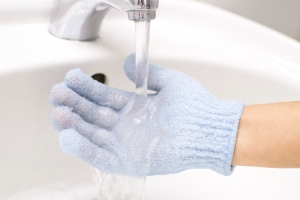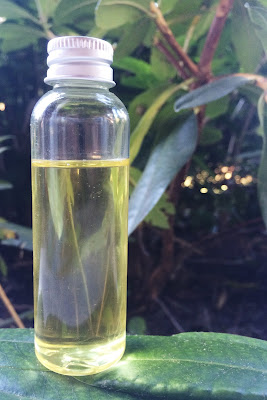Discover Your Natural Skin Care Routine
Thursday, August 20, 2015Enough with the toxic chemicals!
Finding effective, natural skin care products can be hard. Especially with the synthetic chemicals found in our everyday cosmetics.
You walk into a drug store and see an array of moisturizers, cleansers, face masks, anti-aging creams, body scrubs, and so on. For someone who isn't knowledgeable about the beauty world, it's pretty overwhelming.
But don't worry, I've broken all of this down for you. By the end of this article, you'll be a savvy shopper and know exactly how to care for your skin.
How To Identify Natural and Organic Products:
It's important to know how to identify truly natural and organic products when looking for them in stores or online. Simply check the packaging of the product you're interested in buying for third-party certification seals such as the USDA, NSF or NPA, pictured below:The USDA (United States Department of Agriculture) and NSF (National Sanitation Foundation) seals signify an organic product. The NPA (Natural Products Association) seal signifies a natural product, containing a minimum of 95% natural ingredients.
Be cautious about products that don't bear a third-party certification seal, yet claim to be "all natural" or use the word "organic" on their packaging. Read more about these third-party certifications and their standards: USDA, NSF and NPA.
Avoid products that contain:
- Fragrance, parfum, or aroma
- Parabens
- Phenoxyethanol
- Propylene glycol
- Dimethicone
- Diazolidinyl urea
- Tetrasodium EDTA
- Any kind of PEG
If you're ever curious about the healthiness of a product or ingredient, you can search it up in the Skin Deep Cosmetics Safety Database. Alternatively, you can also use the iPhone app Think Dirty to see if their are any potentially toxic ingredients in personal care and beauty products.
With this knowledge, what are the necessary steps and types of products you actually need in order to create your natural skin care routine?
Step One: Cleanse
Cleanse morning and night to remove makeup, excess oil and dirt.Bubble and Bee's Cool Cucumber Facial Cleanser is gentle and great for people with sensitive, oily or acne-prone skin.
Instead of cleansing, you can simply wash your face with a warm washcloth. It's just important to have a clean face before moisturizing.
The Oil Cleansing Method:
My favorite method is oil cleansing. Basically, you massage plant oils onto your skin and then simply wash it off. After that, slap on a little more to replenish the oils in your skin. And voila - that's oil cleansing.The oil cleansing method is based on one of the most basic principles in chemistry, like dissolves like. In this case, oil dissolves oil. By doing so, you're essentially removing the impurities from your skin.
It seems scary slathering oils all over your face to cleanse it, and even I was skeptical at first, but I've personally had success with it. A healthy glow to your skin is usually expected, but for me, it does help to prevent breakouts (along with the rest of my routine) - but you have to use the right oils for you skin type.
Read more about the Oil Cleansing Method (and what oils to use for your skin type) in our recent post here.
Step Two: Exfoliate
Gently exfoliate up to four times a week after cleansing to remove dead skin cells and uncover a fresh new face below.Moisturizers will be able to penetrate more deeply into the skin and in turn will make them more effective.
 |
| Exfoliating Gloves |
Absolutely no mess involved and your skin will love you for it! They last a very, very long time. By far the best investment you can make.
Start here for a pair of $11.95 bamboo exfoliating gloves.
Optional: Facial Mask
Clays are often the base of a facial mask product, or simply used by themselves. They contain a power house of vitamins and minerals. Clays such as bentonite, kaolin and rhassoul have the ability to remove impurities (dirt and bacteria) and heal skin issues, tighten and give skin a healthy glow.
I really recommend buying your own natural clay at a health food store, or anywhere you can find some. This way you'll avoid water-based facial mask products, filled with unrecognizable ingredients.
Once you get your clay, all you have to do is add water and make it into the consistency you like best. You can go ahead and add honey and oils for added benefits. Leave on face for 15-20 minutes or until dry. Wash.
Step Three: Tone
Tone after cleansing and exfoliating or whenever skin feels dry and needs refreshing.Toning is important for balancing the skin's natural pH level and for removing any leftover makeup, dirt and oil.
Acure's Balancing Rose + Red Tea Facial Toner is great because it's a blend of organic herbs, including rooibos and witch hazel. They're natural astringents that help to shrink pores, relieve irritation and restore healthy pH of the skin.
Or... Simply make your own DIY green tea toner:
- Strongly steep green tea into roughly one cup water and allow it to cool to room temperature. Pour it into a sealable container.
- Add a couple drops of essential oil or some honey (optional) to make it more effective. Some essential oils you could use are tea tree and lavender oils for acne-prone skin, and frankincense oil for its anti-aging benefits. Manuka honey would be the best option for its skin healing qualities.
- Apply it to your face using a face cloth or cotton ball. You can also invest in a small sprayer.
- Store it in the fridge and be sure to make a new batch each week. It's a natural product and it will go bad quickly.
Step Four: Moisturize
Moisturize your skin after toning.- Treat sensitive skin.
- Improve skin tone and texture.
- Create a barrier on the outermost layer of skin. This helps to prevent water loss and protect from environmental stress.
- Free-radical scavenge (prevents the degradation of collagen and elastin, two important nutrients in your skin that provide firmness and elasticity).
- Prevent and treat aging skin.

Just use oil!
For moisturizing, oil is the most effective and frugal way to keep your skin soft, healthy and young. They have the potential to do all of the bullets listed above.
Lotions are usually made up of 70-80% water. While this doesn't necessarily make it bad (just a huge money waster), the remainder of the formula contains emulsifiers, thickeners, preservatives and so on...
Contrary to popular belief, most natural oils aren't going to make you break out. If you decide to cleanse your face with oil, moisturizing with it makes the process all the more easy!
And guess what! All you have to do is apply a pea-sized amount to your face (and yes, definitely use oil on the rest of your body). More bang for your buck.
Organic olive, sunflower, and avocado oils are a great way to boost the nutrient value of your beauty routine. They're cheap and won't clog your pores.
I have to admit, moisturizing your skin with oil does take some getting used to. People like that "hydrating" feeling when they use lotion, and using just oil doesn't give you that effect.
Beauty hack: Put some oil on your fingers, wet under tap, apply. Now you have that lotion-y feel without all of the toxic chemicals ;)
Use your own oil or try out Bubble and Bee's Organic Face Cream. It only contains three ingredients (shea butter, rosehip seed oil, and vitamin E). It's an excellent moisturizer.
Avoid mineral oil. There's a lot of controversy online and in the real world as to whether this ingredient is good or bad for you. Basically, It's a by-product of tar and used in many beauty products. It blocks your pores and doesn't allow your skin to breathe, causes hormone disruption in the body, and may contribute to cancer. Not very appealing...
Sun Protection:
Taking it one step further, use a product with an SPF to prevent UV oxidation. Sun exposure plays a huge role in premature aging. So, if you're a frequent user of tanning beds or use baby oil to tan, stop!! For the sake of your health and skin, please stop.Badger's SPF 15 Unscented Sunscreen Cream is USDA organic and made only with botanical oils and zinc oxide (a safe, mineral sunscreen ingredient).
Conclusion:
First cleanse, then exfoliate, then tone, and lastly, moisturize.With all of that taken into consideration, the time to start your natural skin care routine is today!
What kind of skin care routine do you currently follow? Let me know!















0 comments